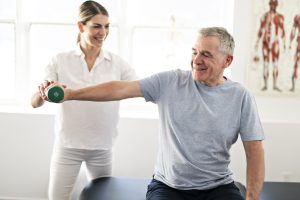Recovering From Total Shoulder Replacement – What Level of Activity Can I Expect?
 Total shoulder arthroplasty, also known as shoulder replacement, is a common surgical procedure used to treat severe pain and mobility restrictions typically caused by osteoarthritis in the shoulder joint. If you’re contemplating undergoing a shoulder replacement, you may wonder what recovery looks like following surgery.
Total shoulder arthroplasty, also known as shoulder replacement, is a common surgical procedure used to treat severe pain and mobility restrictions typically caused by osteoarthritis in the shoulder joint. If you’re contemplating undergoing a shoulder replacement, you may wonder what recovery looks like following surgery.
The expectation for a shoulder replacement is to return to normal functional activities, including hobbies, exercise, and household chores, without pain or limitation. However, it does take time and consistency in participation from the patient with guidance from the physician and physical therapist to achieve these goals.
In the blog post below, Orthopaedic Hospital of Wisconsin physical therapist Cayla Hoof, PT, DPT, of Cedarburg Physical Therapy, discusses recovering from a total shoulder replacement.
Recovery Time
Everybody will recover differently from shoulder joint replacement. There are several factors to consider for recovery time. These factors include activity level before surgery, comorbidities, consistency and compliance with physical therapy, and post-surgical complications.
Following surgery, one can expect a hospital stay of 1 – 3 days for proper monitoring and ensuring safety with return to home. Typically, the first few weeks consist of managing pain and swelling, improving shoulder mobility, and improving shoulder, elbow, wrist, and hand strength. Combined, all these factors play a part in the patient’s ability to return to independence with daily activities. Following the first few weeks, physical therapy focuses on returning the patient to their prior level of function, including hobbies, exercise, and activities.
Hospital Stay
Immediately following surgery, patients will work with multiple hospital staff, including physical therapists, occupational therapists, and nurses, to perform activities to be able to return home. These activities include getting in and out of bed, moving from sitting to standing, dressing, bathing, and grooming to ensure the patient can perform these safely at home. In addition, physical and occupational therapy will help set up an at-home exercise program to promote properly moving the joint. Before returning home, patients will receive a safety assessment to ensure that they are safe to return home, which may include getting in and out of vehicles, transferring from bed and chairs, and dressing/bathing.
Home Recovery
After the hospital stay, the patient typically will return home but may require assistance with daily activities, including cooking, cleaning, laundry, dressing, bathing, and driving to/from appointments. Those who do not have the help they need at home may visit a rehab facility for 1 – 2 weeks to improve their independence and safety at home. Patients will continue with any physical therapy or recommended exercises and follow up with their surgeon.
Physical Therapy and Shoulder Joint Replacement

Typically, most patients will participate in physical therapy or a recommended exercise routine for 6 – 12 weeks (about three months) following surgery. Exercises will include activities to achieve independence with daily activities, chores, and work-related tasks. Gentle impact activities are recommended following surgery, which include walking, cycling, strength training, bowling, gardening, ballroom dancing, and pickleball. High-impact activities with a higher risk of falling with the potential of damaging the surgical joint are not recommended. However, patients should always discuss what is best following surgery with their surgeon and physical therapist.
Are you considering a total shoulder replacement? Consult with our team of orthopedic experts to see if the procedure is for you. Make an appointment online or call (414) 961-6800.

